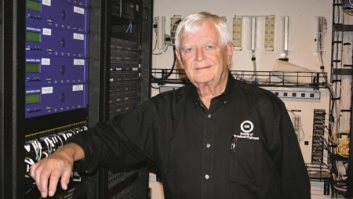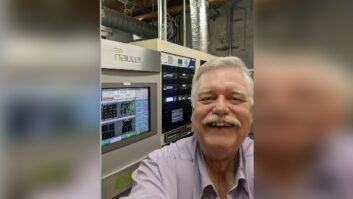LOS ANGELES While many radio engineers are still scratching their heads about when and how to implement HD Radio at their stations, Pablo Garcia has left those questions far behind.
Garcia, the director of engineering for classical-formatted public radio powerhouse KUSC(FM) in Los Angeles, has completed total rebuilds and digital upgrades of the transmission plants for three of the four full-service noncommercial FM stations owned by the University of Southern California.
KPSC(FM) at 88.5 MHz in Palm Springs, KFAC(FM) at 88.7 MHz in Santa Barbara and KCPB(FM) on 91.1 MHz in Thousand Oaks have new transmission facilities built around Broadcast Electronics digital transmitter packages and are broadcasting IBOC signals.
Nearly identical air chains
The three stations simulcast the programming of KUSC via satellite from new studios in downtown Los Angeles, completed in 2001 to support the operations of multiple stations and the Classical Public Radio Network, a partnership with Colorado Public Radio that serves classical stations around the country.
“It’s gone very well,” Garcia said of the installations. He pointed to the similarity of the transmission plants and the use of one equipment vendor as factors that allowed him to complete three transmitter replacement projects within two months. The three stations have virtually identical air chains, varying only in the size of transmitters and antennas.
The satellite feed of KUSC programming is received at each site on two redundant Radyne ComStream ABR700 digital audio demodulators, while an additional ComStream ABR202 receives a data channel containing cue signals.
A local single-box ENCO Systems automation system at each site stores localized underwriting spots and station IDs in 6:1 MPEG Layer II format, the same used at the KUSC production center in Los Angeles. Updates of audio files and system maintenance are performed remotely with pcAnywhere.
Contact closures from the ABR202 data receiver control the ENCO system and a Broadcast Tools AES switcher to allow automation of local inserts. The output of the switcher feeds a Broadcast Electronics Fsi 10 signal generator, through an Orban 8400HD audio processor and into the station’s exciter.
Three-kilowatt KPSC in Palm Springs was the first to receive an upgrade, beginning digital broadcasts on Aug. 1 with a BE FXi 250 exciter and FMi 402 transmitter feeding an ERI LPX two-bay, half — wave — spaced antenna.
KFAC in Santa Barbara followed on Sept. 1, delivering12 kilowatts ERP through a new ERI LPX four — bay fully — spaced antenna, FMi 703 transmitter and FXi 60 exciter.
ERI, BE gear used
KCPB’s installation was completed on Oct. 1, also receiving a new four-bay ERI LPX antenna along with an FMi 301 transmitter and FXi 250 exciter for its 4.8-kilowatt signal.
“Every part of the chain was replaced,” Garcia said. “We’ve been planning this for a number of years, even before HD Radio was ready. The timing worked in our favor, and BE made it possible to go with all-new digital transmitters.”
John Morton is a Broadcast Electronics engineer who worked with Garcia on the project.
“It’s not difficult, just different. There are more connections, done in different ways than what engineers might be used to,” Morton said. “But that just means more cables and new terminology.”
Morton characterizes his experiences with digital conversions to date as “very easy. We just haven’t had a lot of problems” with IBOC. He said the combining method is the biggest variable, advising “if you can do it with low-level (combining), that’s much more efficient.”
The total project cost for the three conversions was $400,000, with half provided by the Southern California-focused Weingart Foundation as a challenge grant and the remainder secured through a targeted capital fundraising effort begun in 1998. The dedicated funding helped to speed the project.
“Since this funding was specifically for the digital conversion of these stations,” Garcia said, “we could do them much more quickly” than a project on this scale funded through the normal capital replacement cycle.
As an extra benefit, KUSC took advantage of Ibiquity’s conversion incentive program, which waived the stations’ licensing fees for HD Radio.
Like other engineers who have taken the HD Radio plunge, Garcia is eager for the day he can monitor his digital broadcasts off-air.
“I heard the signal with BE’s test receiver when we put the Palm Springs station on the air, and it sounded great.”
Garcia says detailed tests of digital coverage, availability and audio quality were scheduled in November, when BE engineers were expected to return with a mobile HD Radio receiver.
In the absence of HD Radio receivers, the greatest result of the project so far is in improvements to the analog signal. “The noise floor is so much lower,” Garcia said. “It’s really fantastic.”
Garcia doesn’t foresee KUSC carving out a possible second audio program channel from the HD Radio bitstream, a goal of NPR’s Tomorrow Radio Project and something of interest to many public radio stations. “We want to use the full 96 kilobits to get the best quality, since we’re a classical station.”
Next up for Garcia: bringing flagship station KUSC into the HD Radio age. He’s still deciding whether to upgrade or replace KUSC’s Harris Z20 transmitter and is awaiting funding, some of which may come from the Corporation for Public Broadcasting’s seed market digital conversion funding program.
Garcia said these three classical public radio signals were the first stations to go on the air with HD Radio in their respective communities of Santa Barbara, Palm Springs and Thousand Oaks. “We’re the first ones, period.”
As he reflected on his experience with the three stations, Garcia said it’s important to remember that the 1s and 0s of digital broadcasting fundamentally alter the responsibilities of transmitter engineers.
“You’re dealing with a computer more than a transmitter,” he says, although the process of setting the various delays in the signal chain reminds him of tuning tube transmitters. “Once you find the sweet spot, everything’s happy.”











